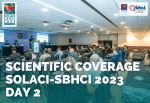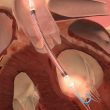The area of records within SOLACI – SOLACI Research – continues to grow and share the results of its investigations with the entire Latin American interventional community. In this case, a dedicated session was held during the SOLACI-SBHCI 2023 Congress to present the data from the SOLACI records and to discuss the challenges of carrying...
1st MINT / MIL Symposium for Women Interventionists Held at SOLACI-SBHCI 2023
Aiming at strengthening equality, promoting leadership and offering educational opportunities to Latin American female interventionists, SOLACI and SBHCI – through their areas MIL and MINT– carried out the “MINT / MIL Symposium: Play to Win” this las Thursday, as part of SOLACI-SBHCI 2023. The activity, which took place at the URCA room of the Windsor...
SOLACI/SBHCI 2023: Scientific Coverage – Day 2
The second day of the SOLACI/SBHCI 2023 Congress, the largest interventional cardiology meeting in Latin America, organized by the Latin American Society of Interventional Cardiology (SOLACI) and the Brazilian Society of Hemodynamics and Interventional Cardiology (SBHCI), held in Rio de Janeiro, featured various national and international guests, along with important sessions on the main topics...
Congress SOLACI-SBHCI 2023 – Day 1 Summary
Today, the SOLACI SBHCI 2023 Congress, the largest interventional cardiology event in Latin America, organized by the Latin American Society of Interventional Cardiology (SOLACI) and the Brazilian Society of Hemodynamics and Interventional Cardiology (SBHCI), began in Rio de Janeiro. The event is taking place between August 2nd August 4th at the Windsor Convention Center &...
Crisis and Socioeconomic Disparities: Relationship with Recurrent Events After Myocardial Infarction
Socioeconomic status (SES) has been linked to recurrent atherosclerotic cardiovascular disease events (rASCVD) after myocardial infarction (MI). However, patients with low SES are underrepresented in most randomized studies. This may be largely due to a higher incidence of metabolic syndrome, insufficient use of recommended medication, such as statins, for secondary prevention and insufficient participation in...
Are There Sex Differences in pLVAD-Assisted High Risk PCI?
The proportion of patients undergoing high risk PCI (HRPCI) is on the rise. It includes patients with different clinical, anatomical and procedural characteristics, such as low ejection fraction, severe vascular disease, three vessel or left main disease, severe lesion calcification and the use of atherectomy. Mechanical circulatory support devices (MCS) during HRPCI, such as the...
No Reflow after Primary PCI in STEMI: An Angiographic Analysis of the TOTAL Study
In the early days of percutaneous coronary intervention (PCI) in patients with ST elevation acute myocardial infarction (STEMI), no reflow phenomenon was known as an indicator of the worst possible outcomes in terms of left ventricular remodeling, infarct size, ejection fraction and mortality, at long term. The TOTAL study (Routine Aspiration Thrombectomy with PCI Versus...
Secondary Prevention with P2Y12 Inhibitors: How Consolidated Is This Long Term Alternative vs. Aspirin?
Secondary prevention with P2Y12 inhibitors vs aspirin monotherapy in CAD patients Antiaggregation therapy plays a central role at long term to prevent new cardiovascular events in atherosclerosis patients. After repeat myocardial infarction (MI) or stroke, prognosis can vary considerably. Even though the current guidelines prefer aspirin as the first choice for secondary prevention over P2Y12...
What Is the Prognosis of an Acute Myocardial Infarction in the Presence of Moderate Aortic Stenosis?
Aortic stenosis (AS) is a common condition that shares risk factors with coronary artery disease. Many patients can suffer from both diseases simultaneously, something that increases the risk of acute myocardial infarction in the presence of aortic stenosis. AS can cause ischemia even in the absence of coronary artery disease, due to ventricular hypertrophy, increased...
Relationship between Distal Vessel Quality and Outcomes in the Treatment of Chronic Total Occlusions
Percutaneous treatment of chronic total occlusions has increase, and has become a a more habitual therapeutic challenge. However, there is limited information on distal vessel quality and its association with outcomes and techniques. This variable appears to be excluded form CTO scores, except for the RECHARGE (REgistry of CrossBoss and Hybrid procedures in FrAnce, the...









